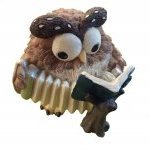Search the Community
Showing results for tags 'volume'.
-
Hi all, It has been a long while since I have written, but I have a topic that I think some of you will find interesting. I've developed tinnitus in my left ear over the past couple of years and while I do not have hearing loss, tinnitus can be caused by loud sound exposure. I recently got an I-watch and started getting loud-noise alerts when I practice or play at sessions/jams. I've now realized that practicing brings decibel levels into the 95-100 dB range and sessions regularly go above 100 to 103 dB or more. (ps the problem with fiddlers losing hearing is well known and they have 90 dB under their ear). Although I have used musician ear plugs before in large sessions, they made the sound muffled and the concertina sound all but dissappeared in a large setting. A musician friend told me about Loop earplugs that are calibrated to take out a range of frequencies with slightly more removed in high frequency ranges. I ordered the Engage (16 dcb removal), and have been practicing and playing with them for about a month. The earplugs work and I can hear myself in a session and I no longer feel worn out sound-wize after an hour or more of practice. I like that I am protecting my hearing in the long term, so I will keep using them. Here is the really wild part to me. In some ways I like it better, I can hear what I am doing better in a session and scary or not, I think it will change my playing because I am hearing differently. In a session, I have no problem hearing the instruments around me, except if a guitar is too far away it just sounds like a rhythmic jumble - I can't hear the chords as cleanly. My concertina sounds really different to my ear, the brightness, the reediness and button sounds on the notes is calmed down and the pure sounds come through. I hear the high and low notes, so the frequency seems to be consistently suppressed across the range (side note, I love all those raspy bits of the concertina, so I miss that). Strangely I feel hearing through the earplugs helps me connect the notes better because I can hear the little gaps. It also lets me control bellows better, ie the dynamics within a single note or phrase, because my ear is not maxed out with the sound. It feels like It seems harder to add chording, but maybe that will improve with time. I have to be careful to not play loud to compensate for the smaller concertina sound in my ear, but I am adjusting to that as well and my friends are helping reassure me that it is not too loud. (or any louder than normal haha). One other thing is that when I took them out at a session, I expected to hear myself better, but actually found that it was worse. There is just so much sound from all the players, that the relative volume of my instrument is no louder without the ear plugs than it is with them in and the cleaner sound with them in helped me have more control playing. I have yet to play with them at a gig and I am not sure I would want to do that because I want to hear all the nuances from myself and others. Even so, the fact that I have been conserving my hearing when I can makes me feel better about having some exposure to loud sounds at a gig. Has anyone else tried this? If so, can you share your thoughts about what you hear when "plugged" and if it affects your playing? All the best, Claire
-
For a number of years now a friend on mine has been building an experimental electronic Anglo concertina. He has now arrived at a reasonable working prototype. One of the features of this concertina is volume modulation using a twin port differential pressure sensor. One port of the sensor is connected to the bellows enclosure and the other the outside world. The actual differential pressure variation measured in the bellows during playing proves to be quite small, that is, less than 3 kilo pascals. Finding affordable sensors with that low pressure range has proved difficult. However, using a Chinese manufactured CFSensor XGZP190 3kPa is currently under investigation. The has led me to think about other ways to measure this activity that do not involve pressure sensors. Fundamentally, the energy expended by the player in moving the bellows end plates is transferred to the reeds and converted into sound. The force being exerted on each end plate can be measured using a load cell sensor of some sort placed where the heel of the hand meets the end plate. This force will be divided equally between all the currently pressed buttons. If the additional force applied by fingertips holding buttons down can be ignored, then a simple calculation to provide a numeric value that is applied to all the “voices” currently playing can be made. if the hand grips were hinged at the top with limited movement at the bottom then push and pull could be differentiated as well as measured. Otherwise a differential pressure sensor may still be needed purely to detect pushing or pulling. My friend says that this may have to wait for a future version! Apologies if this has been tried before. But any comments will be appreciated.
- 45 replies
-
- anglo
- electronic
-
(and 2 more)
Tagged with:
-
In another thread: Boyd Wheatstone Concertinas BW77 mentions some experiments with muting the volume of selected reeds: I have tried a leather baffle on the LHS of my Peacock and while it reduced the volume it also changed the tone. Most of the time I don't use the baffle. Another problem is that it reduces the volume of all of the reeds on that side, whereas I only want to lower the volume of the lowest reeds. I tried 'feathering' the bass buttons with my fingers to see if I could get a decent volume reduction with a very slight button press, but there seems to be quite a cliff edge between sound and no sound so I am not sure if this technique will work for me. I might try some additional washers to see what happens - it is a simple, non-destructive experiment. Then BW77 mentions taping over the pad holes with 'quite interesting' results. Please elucidate. Is that interesting in a good way or a bad way?
-
A few of the higher reeds on my 1914 Wheatstone English tenor-treble sound thin, with less volume than others. I suspect the instrument has been played a lot more in its middle and lower ranges than up high, so part of the difference might be a difference in how much playing-in the different reeds have undergone over the years. The feeble notes speak quite freely and start just as quickly as the others - they just produce a noticeably weaker sound. I have a later Wheatstone (1928) and that has a fairly consistent volume up the scale, which I'd like to achieve in the 1914 one. Is this possible? How can I turn up the volume a tad on those weaker notes? In some cases it's just one of the pair - so the draw speaks louder than the pull or vice-versa. Any guidance would be appreciated. Ray



